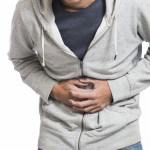- Constipation usually means that your bowel movements are too hard.
- High fiber foods such as fruits, vegetables, and whole grains help prevent constipation.
- Leaving time in the morning to use the bathroom before work or school is helpful.

Teens usually don’t talk about their bathroom habits with their friends but if they did, they would find out that everybody has trouble having a BM or bowel movement (pooping) every once in a while. This usually isn’t a serious problem.
What does it mean if you are “constipated”?
Becoming constipated means that you have a change in your bowel habits with fewer BM’s each week and/or pain when you have a BM. When you’re constipated your BM’s are usually too hard or too small. Some people may strain when they try to have a BM or feel like they don’t have a complete BM. Although everybody’s bathroom habits are different, you are likely to be constipated if you’re having 3 or fewer BM’s in a week. Sometimes people may wait so long to try and have a BM (because they think it’s going to hurt), that they get even more constipated.
What causes constipation?
Some medical conditions such as diabetes, irritable bowel syndrome, and low thyroid can cause constipation. Medications such as strong pain pills, antidepressants, and antihistamines can also cause constipation. Most of the time, however, constipation happens for reasons such as waiting too long to go to the bathroom and not having enough fiber or liquids in your diet. The good news is that dietary and lifestyle changes can keep you “regular” and help you feel better.
What are the signs of constipation?
Although there is no “right” number of BM’s a person should have, you will generally feel better if you have a BM every day or at least every other day.
Not having regular BM’s can cause stomach pain. Most people have pain before they pass a large, hard BM. Some people with constipation may notice bright red blood on the toilet paper or a streak of blood on their BM. This bleeding is a sign that the anus (the hole where the BM comes out) has been irritated. This can cause an “anal fissure” (a tear in this area) or a “hemorrhoid” (swollen tissue near the anus that is painful and often bleeds when a hard BM is passed). If this happens, it can be scary to see blood, but the soreness and bleeding will generally go away when you start having regular and soft BM’s. You should make an appointment with your primary health care provider (PCP) so they can tell you what can help you. Your PCP may suggest warm baths, a high-fiber diet, drinking more water, and over the counter medicines and/or ointments to make you feel more comfortable and help the fissure heal.
What helps constipation?
If you’re a teen, you’re probably very busy with school, sports, and other after-school activities. Maybe you don’t have much privacy, or perhaps even finding a bathroom is challenging. But if you have been uncomfortable because of constipation, it may be time to think about how you can feel better!
You will probably want to plan ahead by knowing where the bathrooms are, whether you are at school, playing sports, or hanging out in other places. Next, you’ll need to slowly add more fiber to your diet and drink more water. Finally, exercise is important for good health and can help your digestive system.
Tips:
- Learn to pay attention to your body’s signals.
- Don’t wait too long to find a bathroom when you feel the urge to go.
- Start a habit of going to the bathroom at the same time every day such as 20-30 minutes after a regular meal. You can usually get into a routine if you eat your meals around the same time each day.
- Get up early enough to have breakfast, then get dressed and also save time to go to the bathroom before you leave for school or work.
- Try not to be in a rush when you finally get to a bathroom; if your body is relaxed, it will be easier to go.
- Eat a high fiber diet (see below).
- Drink plenty of water.
- Fit in exercise; walking is a great way to start increasing activity.
Will the food I eat make a difference?
Yes! There are foods that tend to be constipating and there are foods that tend to help your digestive system process food and help get rid of the waste. Foods containing fiber can help prevent constipation. Fiber is found in fruits, vegetables, whole grains, beans, legumes, and nuts. Increase fiber in your diet gradually rather than all at once in order to prevent stomach pain.
How can I work on getting more fiber in my diet?
Here are some tips for increasing your fiber intake:
At breakfast:
- Eat high-fiber cereal or a bowl of oatmeal. When reading the Nutrition Facts Label look for the grams of fiber per serving. A good source of fiber is 3g per serving and a source with 5g or more is considered high-fiber.
- Try whole wheat pancakes or waffles. If making your own, try adding unprocessed bran or All-Bran® to the batter.
- Add some fruit. For example, toss some berries on your cereal, make a fruit and yogurt smoothie, or have a slice of melon.
- Switch to whole grain toast or English muffins.
- Have a small glass of prune juice or a handful of dried prunes.
- Drink a hot beverage that contains caffeine (such as coffee or tea), as caffeine and hot liquids can help to stimulate your bowels.
At lunch:
- Have soup containing beans or legumes, such as minestrone, black bean, or lentil.
- Make your sandwiches on whole grain bread, pita, or wrap. Choose products with 100% whole wheat, rye, oats, or bran as the first ingredient.
- Add some veggies to your sandwich, like tomato, cucumber, leafy greens, or carrots.
- Add a side salad to your meal with dark leafy greens and other vegetables you enjoy such as peppers, carrots, and broccoli.
At dinner:
- Increase your portion of veggies! Have some extra broccoli, squash, or green beans with your meal, or add a side salad.
- Include some beans, such as black beans or kidney beans.
- Try a side portion of whole grain brown rice, whole wheat pasta, or quinoa.
Snack time:
- Have some raw veggies such as peppers, grape tomatoes, or carrots. Try dipping them in hummus.
- Choose a piece of whole fruit, such as an apple (with skin) instead of juice.
- Add high-fiber cereal, unprocessed bran, or flaxseeds to yogurt.
- Make some trail mix with nuts, seeds, and dried fruit or raisins.
- Try a granola or cereal bar that contains oats.
- Have some popcorn (it’s a whole grain!).
- Snack on edamame (soybeans).
As a supplement, if recommended by your health care provider:
- Have a fiber supplement drink, capsule, or gummy such as Metamucil®, Citrucel®, or Benefiber®.
Be sure to drink plenty of fluids when you increase your fiber intake. Otherwise your constipation may actually get worse! In addition, increase your fiber intake slowly to you won’t feel bloated or have diarrhea.
How can reading the food label help me?
When reading the food label, check the amount of dietary fiber a food contains. Look for breads, crackers, granola bars, cereals, pastas, and other grains that have at least 3 grams of fiber per serving. Aim for 25-28 total grams of fiber per day. To figure out whether a food is a whole grain, read the list of ingredients. The first ingredient should be a whole grain, such as whole wheat or oats. Some food labels advertise that a product is “high fiber,” which means that the food contains 5 or more grams of fiber per serving. This might be a natural source of fiber, such as from a vegetable or whole grain, or the product may be fortified, with fiber added to it (such as FiberOne® products).
Are there any foods I should avoid if I’m constipated?
Certain foods such as, candy, cookies, ice cream and other sweets that are generally high in fat and sugar are low in fiber. They can actually make your constipation worse. Try to choose higher fiber foods if you have problems with constipation.
What if I don’t like high fiber foods?
If you are not a fan of high fiber foods such as fruits, veggies, and whole grains, your PCP may suggest that you drink a special powdered drink two or three times a day until you are no longer constipated. Drinking plenty of water and exercising each day may help too.
What about laxatives?
Most of the time constipation will improve with a healthy diet rich in fiber including fruits and veggies, drinking lots of fluids and exercising regularly. If you continue to have symptoms of constipation, your provider may prescribe an over-the-counter laxative.
There are many kinds of laxatives and they all work a little bit differently. They include oral osmotics, oral bulk formers, oral stool softeners, oral stimulants, and rectal suppositories. Some laxatives combine two types such as a stimulant and a stool softener. Most laxatives should be used for short periods of time as your body can get used to needing them to have a BM or can have potentially negative side effects if over used. Some laxatives such as the oral osmotics (ex. Miralax®) are mild and work by pulling water into the colon so that a BM can be passed easier. This type of laxative may be prescribed for an indefinite amount of time. Ask your PCP before you decide to use these treatments.
When should I call my health care provider?
You should call your health care provider if you have:
- bloody stools, vomiting, or stomach pain;
- a loss of appetite
- a fever
- constipation that gets worse or doesn’t get better.
It’s common to be constipated once in a while, but if you have trouble or pain a lot of the time, or if you notice blood when you have a BM, you should make an appointment and talk to your PCP. Decreasing foods that cause constipation, increasing fiber, drinking more water, and exercising will help keep your BMs regular.
Additional Resources:
 Young Men's Health
Young Men's Health
